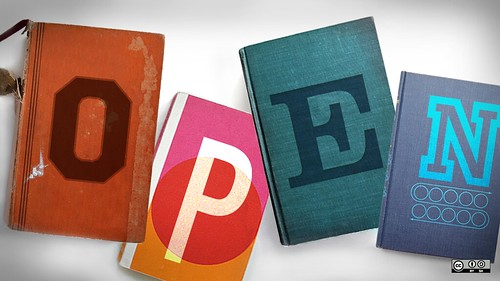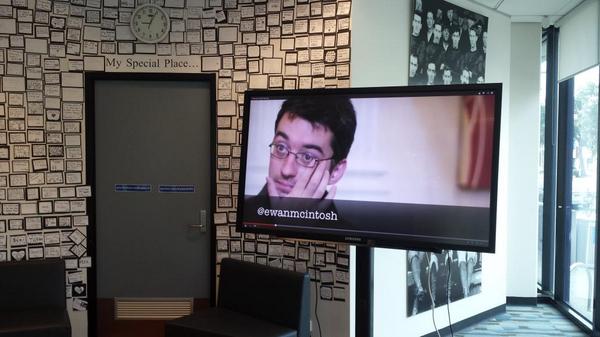 Knowledge building, literacy and communication in action now take many forms. When Skype was first released in 2003, the global face-to-face contact began to transform communication and collaboration in ‘real time’. Now Apple’s Face-Time, Skype in the Classroom, and Google Hangouts (to name just a few tools) guarantee synchronous engagement, alongside collaborative text platforms such as Google docs. In other words, the mechanisms for engaging with information and processes of learning in the acquisition of new knowledge has become a deeper process of individual and collaborative learning activities, problem solving and artefact development, through an integration of face-to-face and online interactions within a community, involving absorption, integration and systemisation of the information received by the receiver in their own pre-existing cognitive structure, which are the result of personal experience, and earlier knowledge transactions (Trentin, 2011).
Knowledge building, literacy and communication in action now take many forms. When Skype was first released in 2003, the global face-to-face contact began to transform communication and collaboration in ‘real time’. Now Apple’s Face-Time, Skype in the Classroom, and Google Hangouts (to name just a few tools) guarantee synchronous engagement, alongside collaborative text platforms such as Google docs. In other words, the mechanisms for engaging with information and processes of learning in the acquisition of new knowledge has become a deeper process of individual and collaborative learning activities, problem solving and artefact development, through an integration of face-to-face and online interactions within a community, involving absorption, integration and systemisation of the information received by the receiver in their own pre-existing cognitive structure, which are the result of personal experience, and earlier knowledge transactions (Trentin, 2011).
This digital information environment demands a new knowledge flow between content and digital connections. While the bibliographic paradigm created textbook learning, the digital information environment of today indicates the need for educators to understand information seeking and engagement within connected multi-media contexts. Computer and mobile device technology environments, social media, and ready forms of online communication drive our newly emerging knowledge ecosystems. Thomas and Brown (2011), who explored what they described as a new ‘culture of learning’, explained how much the Internet has changed the way we think about both technology and information. In this new culture of learning, information technology has become a participatory medium, giving rise to an environment that is constantly being changed and reshaped by the participation within information spaces. They argue that traditional approaches to learning are no longer capable of coping with this constantly changing world. The information environment is a technology environment, which demands adaptation. As information is also a networked resource, “information absorption is a cultural and social process of engaging with the constantly changing world around us” (Thomas & Brown, 2011, p.47).
In other words, our digital information ecology is a remix of different forms of technology, devices, data repositories, information retrieval, information sharing, networks and communication. New technological tools are expanding and continually altering the ways school students, or educators can interact with the world. The implications for education that stem from new means for accessing information, communicating with others, and participating in a community needs a new brand of professional competences to thrive within the changing environment. Haste (2009) recognised the co-construction of knowledge through interpersonal discourse and the tension within pedagogy between a focus on knowledge-based instruction and outcomes, and on praxis-based instruction. “While most pedagogy, of course, recognises the interaction of both in good practice, there is nevertheless an underlying epistemological gap; knowledge-based models are implicitly more ‘top down’ and praxis-based more ‘bottom up’. ‘Knowledge’ implies that the route to understanding is in the structured transmission of information. ‘Praxis’ implies a necessary interaction with materials, actions or other persons as a route to understanding” (Haste, 2009 p.213).
Information ecology at the heart of knowledge
While technology is changing the information environment (including information places and spaces), the transactional nature of information interactions and knowledge flow underpins learning. Information can comprise both physical and virtual parts for operation and interaction. A major challenge for education is to enable and facilitate the generation of new knowledge via an appropriate information environment, to facilitate integration of new concepts within each person’s existing knowledge structure. This is described as an ‘information ecology’.
“Information ecology examines the contexts of information behaviour by analogy with ecological habitats and niches, identifying behaviours in biological terms such as ‘foraging’” (Bawden & Robinson, 2012. p.199). In this context of adaptive and responsive co-construction of knowledge, we can facilitate a viable praxis in digital environments, influenced by concepts of rhizomatic learning. “Seen as a model for the construction of knowledge, rhizomatic processes hint at the interconnectedness of ideas as well as boundless exploration across many fronts from many different starting points” (Sharples, et al. 2012 p.33). By creating curriculum and subject delivery which can be reshaped and reconstructed in a dynamic manner in response to changing environmental conditions or the personal professional needs of students, a digital information ecology provides the opportunity to work with information in the construction of knowledge in more dynamic ways, connecting learning experiences across the contexts of location, time, devices and platforms.
This information ecology also involves the creation of assessments and environments for knowledge building to enhance collaborative efforts to create and continually improve ideas. This approach to knowledge building “exploits the potential of collaborative knowledge work by situating ideas in a communal workspace where others can criticize or contribute to their improvement” (Scardamalia, Bransford, Kozma, & Quellmalz, 2012, p.238 ). In this information ecology we also understand that “the development of critical thinking is a key learning objective in education – particularly higher education – [and that] it entails the ability to make reasoned evaluative judgements when making sense of information sources that contain different (potentially conflicting) findings, perspectives and interpretations of a given topic of phenomenon” (Ford, 2008 p. 59). The use of critical thinking has become particularly important as relatively quick access to a wide range of information means that the user needs the ability to critically evaluate the validity and value of information accessed.
The evidence is that technologies and social media platforms are driving an unprecedented reorganisation of the learning environment in and beyond schools and tertiary environments. These disruptive shifts are already reshaping the workforce landscape and the skills required (Davies, Fidler & Gorbis, 2011), establishing lifelong and life-wide learning as the central paradigm for the future (Redecker et al, 2011).
Our work as educators has to centre on helping to meet future learning needs in courses/programs by fostering a culture of enquiry within a sustainable learning ecology that is shaped by the ubiquity of information, globally responsive pedagogical practices, and driven by collaboration and informal learning in multiple access points and through multiple mediums.
Bawden, D., & Robinson, L. (2012). Introduction to information science. London: Facet.
Charles Sturt University. (2012). Course Approval Document. Master of Education (Knowledge Networks and Digital Innovation Articulated Set). CASIMS, Office of Academic Governance.
Davies, Al, Fidler, D., & Gorbis, M. (2011). Future work skills 2020. Institute for the Future for the University of Phoenix Research Institute: California.
Ford, N. (2008). Education. In Web-based learning through educational informatics: Information science meets educational computing. Hershey, PA: IGI Global.
Haste, H. (2009). What is ‘competence’ and how should education incorporate new technology’s tools to generate ‘competent civic agents’. Curriculum Journal, 20(3), 207-223. doi:10.1080/09585170903195845
Redecker, C., Leis. M., Leendertse, M., Punie, Y., Gijsbers, G., Kirschner, P., Stoyanov, S., & Hoogerveld, B. (2011). The future of learning: preparing for change, Institute for Prospective Technological Studies, JRC European Commission.
Scardamalia, M., Bransford, J., Kozma, B., & Quellmalz, E. (2012). New assessments and environments for knowledge building. In Assessment and teaching of 21st century skills (pp. 231-300). Springer Netherlands.
Sharples, M., McAndrew, P., Weller, M., Ferguson, R., FitzGerald, E., Hirst, T., … & Whitelock, D. (2012). Innovating Pedagogy 2012: Open University innovation report 1. Milton Keynes: The Open University.
Thomas, D., & Brown, J. S. (2011). A new culture of learning: Cultivating the imagination for a world of constant change (Vol. 219). Lexington, KY: CreateSpace.
Trentin, G., (2011). Technology and knowledge flows : the power of networks. Chandos Pub, Oxford.
Image: creative commons licensed (BY-NC-SA) flickr photo by katypang: http://flickr.com/photos/katypang/2628074710


 One of the delights of working at Charles Sturt University is being able to range across innovation opportunities – to make a difference!
One of the delights of working at Charles Sturt University is being able to range across innovation opportunities – to make a difference!





 Knowledge building, literacy and communication in action now take many forms. When Skype was first released in 2003, the global face-to-face contact began to transform communication and collaboration in ‘real time’. Now Apple’s Face-Time, Skype in the Classroom, and Google Hangouts (to name just a few tools) guarantee synchronous engagement, alongside collaborative text platforms such as Google docs. In other words, the mechanisms for engaging with information and processes of learning in the acquisition of new knowledge has become a deeper process of individual and collaborative learning activities, problem solving and artefact development, through an integration of face-to-face and online interactions within a community, involving absorption, integration and systemisation of the information received by the receiver in their own pre-existing cognitive structure, which are the result of personal experience, and earlier knowledge transactions (Trentin, 2011).
Knowledge building, literacy and communication in action now take many forms. When Skype was first released in 2003, the global face-to-face contact began to transform communication and collaboration in ‘real time’. Now Apple’s Face-Time, Skype in the Classroom, and Google Hangouts (to name just a few tools) guarantee synchronous engagement, alongside collaborative text platforms such as Google docs. In other words, the mechanisms for engaging with information and processes of learning in the acquisition of new knowledge has become a deeper process of individual and collaborative learning activities, problem solving and artefact development, through an integration of face-to-face and online interactions within a community, involving absorption, integration and systemisation of the information received by the receiver in their own pre-existing cognitive structure, which are the result of personal experience, and earlier knowledge transactions (Trentin, 2011).








